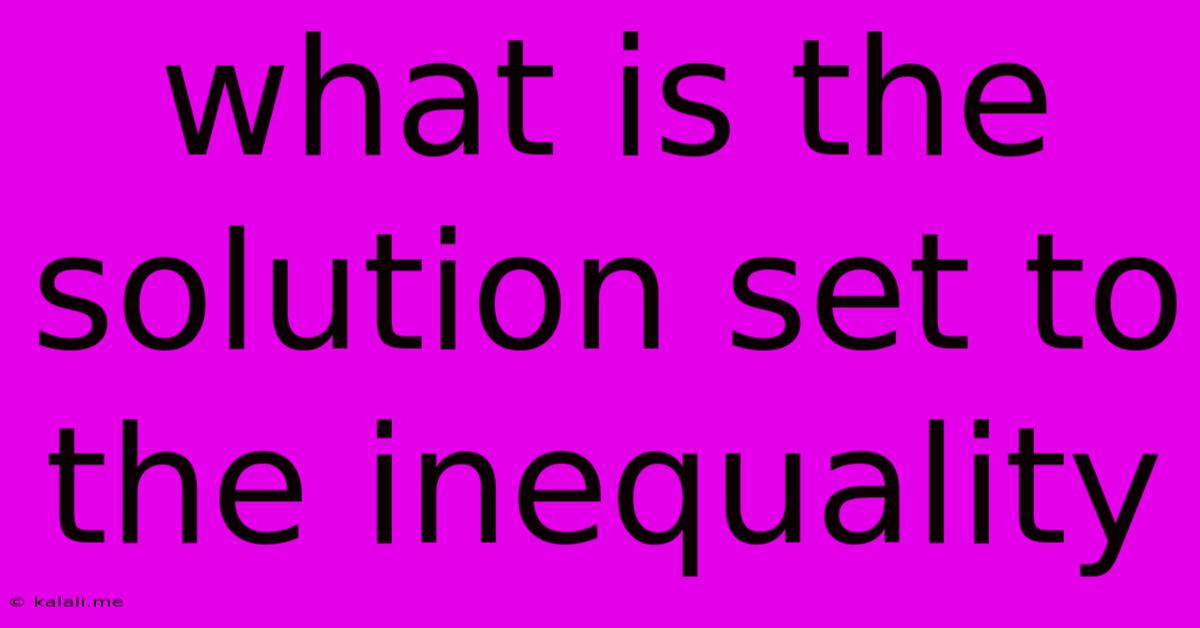What Is The Solution Set To The Inequality
Kalali
May 09, 2025 · 3 min read

Table of Contents
Solving Inequalities: Finding the Solution Set
Finding the solution set to an inequality involves identifying all the values of the variable that make the inequality true. This differs slightly from solving equations, where you're looking for specific values that make the equation hold. This article will explore different approaches to solving various types of inequalities, focusing on techniques that help you arrive at the correct solution set. Understanding inequalities is crucial in various fields, from calculus and linear programming to data analysis and computer science.
Types of Inequalities
Before diving into solutions, let's clarify the types of inequalities we'll encounter:
- Linear Inequalities: These involve a linear expression (e.g., 2x + 3 < 7). They are the simplest type and are solved using basic algebraic manipulations.
- Quadratic Inequalities: These involve a quadratic expression (e.g., x² - 4x + 3 > 0). Solving these requires factoring and considering the parabola's behavior.
- Polynomial Inequalities: These involve polynomials of degree three or higher. Solving them can be more complex and might involve graphing or numerical methods.
- Rational Inequalities: These involve rational expressions (fractions with polynomials in the numerator and denominator). They require careful consideration of the denominator and potential asymptotes.
Techniques for Solving Inequalities
The approach to solving an inequality depends on its type. Here's a breakdown of common techniques:
1. Linear Inequalities:
Solving linear inequalities involves isolating the variable. Remember that multiplying or dividing by a negative number reverses the inequality sign.
Example: Solve 2x + 3 < 7
- Subtract 3 from both sides: 2x < 4
- Divide both sides by 2: x < 2
The solution set is all real numbers less than 2, often represented as (-∞, 2) in interval notation.
2. Quadratic Inequalities:
Solving quadratic inequalities usually involves factoring the quadratic expression and analyzing its sign. This can be done using a sign chart or by considering the parabola's intercepts and concavity.
Example: Solve x² - 4x + 3 > 0
- Factor the quadratic: (x - 1)(x - 3) > 0
- Find the roots: x = 1 and x = 3
- Analyze the sign: The parabola opens upwards, so the inequality is true when x < 1 or x > 3.
The solution set is (-∞, 1) ∪ (3, ∞) in interval notation. The symbol ∪ represents the union of two sets.
3. Polynomial and Rational Inequalities:
These inequalities often require more advanced techniques, such as:
- Graphing: Plotting the function and identifying the intervals where it satisfies the inequality.
- Sign Charts: Creating a chart to analyze the sign of the expression across different intervals determined by the roots and asymptotes.
- Test Points: Choosing test points within each interval to determine the sign of the expression.
Important Considerations:
- Interval Notation: Always express your solution set using interval notation (e.g., (a, b), [a, b], (a, b], [a, b)) to clearly communicate the range of solutions. Square brackets indicate inclusion of the endpoint, while parentheses indicate exclusion.
- Undefined Values: For rational inequalities, remember to exclude values that make the denominator zero, as they are undefined.
- Compound Inequalities: Inequalities can involve multiple conditions (e.g., x > 2 and x < 5, which can be written as 2 < x < 5).
By understanding these techniques and applying them systematically, you can effectively solve a wide range of inequalities and determine their solution sets accurately. Remember to always check your solution by plugging in values from the solution set back into the original inequality to confirm they satisfy the condition. Practice is key to mastering inequality solving.
Latest Posts
Latest Posts
-
What Is 20 Percent Off Of 39 99
Jul 03, 2025
-
Where Is The 3 In Riddle Transfer
Jul 03, 2025
-
How Much Does A Water Bottle Weight
Jul 03, 2025
-
How Many Inches Is Half A Yard
Jul 03, 2025
-
How Old Are You If Your Born In 1996
Jul 03, 2025
Related Post
Thank you for visiting our website which covers about What Is The Solution Set To The Inequality . We hope the information provided has been useful to you. Feel free to contact us if you have any questions or need further assistance. See you next time and don't miss to bookmark.